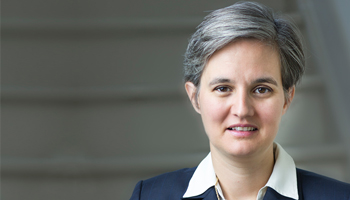HOW CAN WE HELP YOU? Call 1-800-TRY-CHOP
In This Section
Leukodystrophy Research, Advocacy Mission Critical for New Program Director
 A special space is open on the walls of Adeline L. Vanderver, MD’s, new office for a framed collage of “Commander” Massimo “Mo” Damiani, a toddler wearing an orange jumpsuit who looks ready to join a NASA astronaut team. Dr. Vanderver, a child neurologist and geneticist, helped to pinpoint his rare subtype of leukodystrophy, a group of inherited degenerative diseases that affect the white matter in the brain and spinal cord. Gratified to have a diagnosis after three years of searching, Mo’s father sent Dr. Vanderver the portrait with the message, “Mission Accomplished.”
A special space is open on the walls of Adeline L. Vanderver, MD’s, new office for a framed collage of “Commander” Massimo “Mo” Damiani, a toddler wearing an orange jumpsuit who looks ready to join a NASA astronaut team. Dr. Vanderver, a child neurologist and geneticist, helped to pinpoint his rare subtype of leukodystrophy, a group of inherited degenerative diseases that affect the white matter in the brain and spinal cord. Gratified to have a diagnosis after three years of searching, Mo’s father sent Dr. Vanderver the portrait with the message, “Mission Accomplished.”
Dr. Vanderver’s planned trajectory as the new program director of the Leukodystrophy Center of Excellence at Children’s Hospital of Philadelphia aims to take leukodystrophy gene discovery, advocacy, supportive care, and ultimately therapies even further — perhaps to infinity and beyond.
In 2009, 1-year-old Mo was enrolled in a research project that Dr. Vanderver was running out of her lab at the Children’s National Medical Center in Washington, D.C., to perform whole genome sequencing for unclassified white matter disorders. At the time, almost 50 percent of patients suspected of having a form of leukodystrophy didn’t attain a specific molecular diagnosis.
“We knew they had a problem with the white matter of their brain, but we didn’t know what caused it, what their prognosis might be, and what their lifespan might look like,” Dr. Vanderver said. “And so initially I became interested in helping provide an end to their diagnostic odyssey and provide better access to diagnostic services for those patients.”
And that is exactly what Dr. Vanderver did when she used next-generation sequencing applications to discover that mutations in the DARS gene were the reason why Mo had lost basic skills such as crawling, sitting, and talking shortly after his first birthday. Leukodystrophies are caused by genetic defects that affect growth or formation of the myelin sheath, which is soft, white, fatty material that acts as insulation surrounding nerve fibers. Without this protective coating intact, brain signals don’t travel effectively, and children with leukodystrophies face a range of potentially devastating neurological problems that in some cases can lead to a rapid decline in movement, speech, vision, and hearing.
Currently, leukodystrophies number about 30 disorders, and scientists estimate they occur in one in 7,000 births. Yet, leukodystrophies remain widely under-recognized outside and within the pediatric medicine community, Dr. Vanderver said. She works closely with the Global Leukodystrophy Initiative, an advocacy group that includes parents, clinicians, and researchers, to raise disease awareness and ensure that patients receive appropriate social and medical support.
Usually, when a child is diagnosed with a type of leukodystrophy, the family has never heard of the disorder before, which can seem intimidating and frightening, Dr. Vanderver said. Medical practitioners can be equally uninformed and send parents the incorrect message that there is nothing that can be done to help their child.
“Most of these disorders are not curable at this point, but that doesn’t mean they’re untreatable,” Dr. Vanderver said. “A large amount of symptomatic management can be done to improve their health outcomes and quality of life.”
In her new role, Dr. Vanderver and the multidisciplinary staff at the Leukodystrophy Center of Excellence will be creating standards of care for patients to optimize their disease management. In parallel with this strong clinical program, she will spearhead pre-clinical and clinical research projects to discover molecular therapeutics that target the genetics of leukodystrophy subtypes.
Already, Dr. Vanderver is leading two clinical studies that intend to repurpose medications — one that is currently used to treat human immunodeficiency virus and another that targets interferon — for patients with Aicardi-Goutieres syndrome. Another clinical trial that she has underway is assessing the efficacy and utility of whole genome sequencing as a first-line diagnostic test for leukodystrophies.
“We’re hopeful that we’ll be able to take that list of 30 disorders and check them off one by one to get them diagnosed earlier and eventually to deliver therapeutics,” Dr. Vanderver said. “Because that would really be mission accomplished.”
She’ll need a top flight crew to reach those new frontiers, which is partly why Dr. Vanderver is excited to be a new CHOP investigator. She is eager to meet with other clinicians and researchers interested in exploring leukodystrophies or overlapping conditions.
“CHOP has an overall infrastructure that is very supportive, and there are wonderful collaborators to partner with,” said Dr. Vanderver, who also holds the Kamens Endowed Chair in Neurological Disorders and Translational NeuroTherapeutics at CHOP.
The Leukodystrophy Center of Excellence launched in May 2015 to support newborn screening for degenerative inherited white matter diseases, provide integrated multidisciplinary care, and advance research. Amy Waldman, MD, a CHOP pediatric neurologist, is medical director of the Center, which sees patients with leukodystrophies from all over the country and the world.